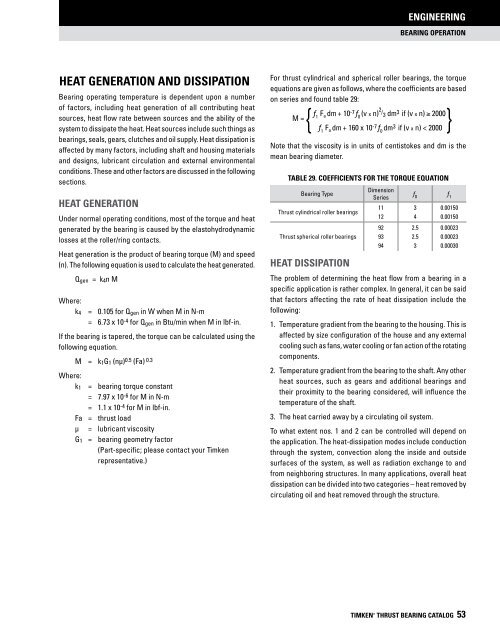You also want an ePaper? Increase the reach of your titles
YUMPU automatically turns print PDFs into web optimized ePapers that Google loves.
ENGINEERING<br />
Bearing Operation<br />
HEAT GENERATION AND dissipation<br />
Bearing operating temperature is dependent upon a number<br />
of factors, including heat generation of all contributing heat<br />
sources, heat flow rate between sources and the ability of the<br />
system to dissipate the heat. Heat sources include such things as<br />
bearings, seals, gears, clutches and oil supply. Heat dissipation is<br />
affected by many factors, including shaft and housing materials<br />
and designs, lubricant circulation and external environmental<br />
conditions. These and other factors are discussed in the following<br />
sections.<br />
heat generation<br />
Under normal operating conditions, most of the torque and heat<br />
generated by the bearing is caused by the elastohydrodynamic<br />
losses at the roller/ring contacts.<br />
Heat generation is the product of bearing torque (M) and speed<br />
(n). The following equation is used to calculate the heat generated.<br />
Where:<br />
k 4<br />
Q gen = k 4n M<br />
= 0.105 for Q gen in W when M in N-m<br />
= 6.73 x 10 -4 for Q gen in Btu/min when M in lbf-in.<br />
If the bearing is tapered, the torque can be calculated using the<br />
following equation.<br />
M = k 1G 1 (nμ) 0.5 (Fa) 0.3<br />
Where:<br />
k 1 = bearing torque constant<br />
= 7.97 x 10 -6 for M in N-m<br />
= 1.1 x 10 -4 for M in lbf-in.<br />
Fa = thrust load<br />
µ = lubricant viscosity<br />
G 1 = bearing geometry factor<br />
(Part-specific; please contact your <strong>Timken</strong><br />
representative.)<br />
For thrust cylindrical and spherical roller bearings, the torque<br />
equations are given as follows, where the coefficients are based<br />
on series and found table 29:<br />
f<br />
M = 1<br />
F dm + a 10-7 f 0<br />
(v x n) 2 / 3 dm 3 if (v x n) 2000<br />
f 1<br />
F dm + 160 x a 10-7 f 0<br />
dm 3 if (v x n) < 2000<br />
{<br />
Note that the viscosity is in units of centistokes and dm is the<br />
mean bearing diameter.<br />
TABLE 29. Coefficients for the torque equation<br />
Bearing Type<br />
<strong>Thrust</strong> cylindrical roller bearings<br />
<strong>Thrust</strong> spherical roller bearings<br />
heat dissipation<br />
Dimension<br />
Series<br />
11<br />
12<br />
92<br />
93<br />
94<br />
f 0 f 1<br />
3<br />
4<br />
2.5<br />
2.5<br />
3<br />
0.00150<br />
0.00150<br />
0.00023<br />
0.00023<br />
0.00030<br />
The problem of determining the heat flow from a bearing in a<br />
specific application is rather complex. In general, it can be said<br />
that factors affecting the rate of heat dissipation include the<br />
following:<br />
1. Temperature gradient from the bearing to the housing. This is<br />
affected by size configuration of the house and any external<br />
cooling such as fans, water cooling or fan action of the rotating<br />
components.<br />
2. Temperature gradient from the bearing to the shaft. Any other<br />
heat sources, such as gears and additional bearings and<br />
their proximity to the bearing considered, will influence the<br />
temperature of the shaft.<br />
3. The heat carried away by a circulating oil system.<br />
To what extent nos. 1 and 2 can be controlled will depend on<br />
the application. The heat-dissipation modes include conduction<br />
through the system, convection along the inside and outside<br />
surfaces of the system, as well as radiation exchange to and<br />
from neighboring structures. In many applications, overall heat<br />
dissipation can be divided into two categories – heat removed by<br />
circulating oil and heat removed through the structure.<br />
{<br />
TIMKEN ® THRUST BEARING CATALOG 53

















